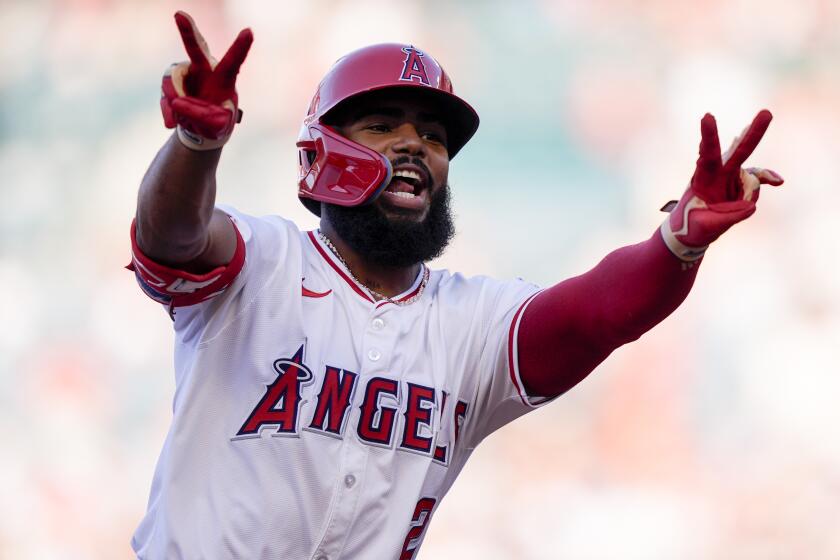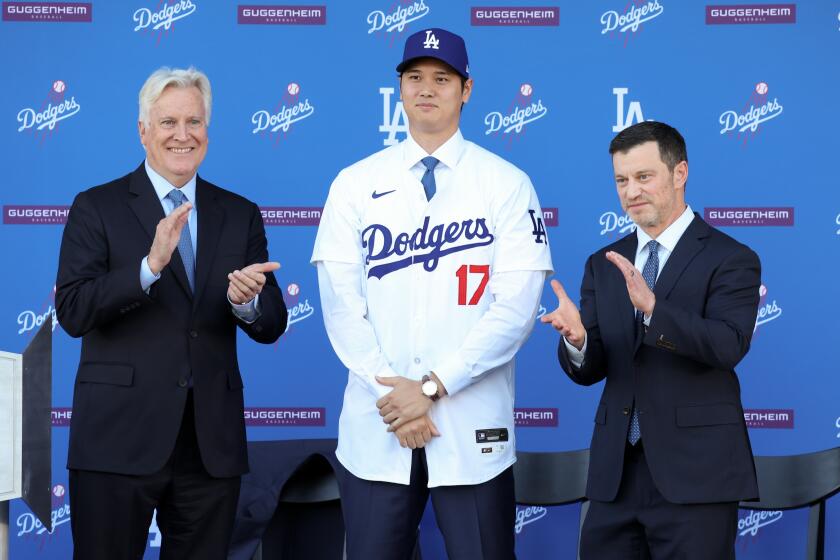In the post-Vin Scully era, what do you want in a baseball broadcast, Dodgers fans?
- Share via
What do you want in a baseball broadcast?
Two thoughts came to mind on watching the Dodgers’ first television broadcast of the post-Vin Scully era: 1) this is pretty good; 2) this is pretty generic. No longer can the Dodgers boast of a broadcast distinguished above all others.
The Dodgers had the best broadcast, of course, because they had the best broadcaster in baseball history. Scully worked alone, talking to the viewer as a friend, weaving stories between pitches, never having to stop so an analyst could chime in.
These days, of course, a one-man booth is an anachronism. The modern commandment: Thou shalt not go on the air without a play-by-play announcer and a color analyst — or two.
In a sport where a statistical revolution makes “we’ve always done it that way” an unsatisfying explanation for game strategies and roster building, why should a two-man booth be the unchallenged norm?
Craig Calcaterra at Hardball Talk described an analyst as “almost always an ex-player who cares a lot about ex-player things such as where someone learned a cutter and who’s a good guy in the clubhouse.”
After watching the Dodgers’ first post-Scully broadcast, he suggested that a team — maybe even the Dodgers — try a one-man booth again.
Scully’s one-man booth worked so well primarily because Scully was the man. He read voraciously, and not just about sports.
He spotted a trend of bearded players last year, read up on the history of beards, and dropped Deuteronomy, Leviticus, Alexander the Great and Abraham Lincoln into his broadcast without missing a pitch. And, of course, he had done the research to introduce players by their life stories, not just by their statistics.
The new wave of statistics offers a new way to present the game to viewers, but broadcasters should not make the mistake of force-feeding a diet of those statistics to the casual fan. ESPN was deservedly mocked for decorating its broadcasts this week with “win probability,” as if a fan cannot figure out that a five-run deficit in the seventh inning would make for a mighty steep comeback.
Joe Davis, the Dodgers’ new voice, is conversant with those statistics. He also is well aware of his audience.
“People don’t want to tune into a math lesson,” he told The Times.
“This is part of the game now. This is where the game has gone. We have some responsibility to educate them. But there’s a fine line between educating them and bludgeoning them with numbers.”
While there are some fans that might be interested in Davis’ explanation of fielding-independent pitching, there might be others interested in his grilling tips. It’s all in the presentation, either way.
So what do you want in a baseball broadcast? One voice, or two, or more? More statistics, or more stories? What makes a broadcast most watchable for you?
Let us know in the comments.
Follow Bill Shaikin on Twitter @BillShaikin
More to Read
Go beyond the scoreboard
Get the latest on L.A.'s teams in the daily Sports Report newsletter.
You may occasionally receive promotional content from the Los Angeles Times.











